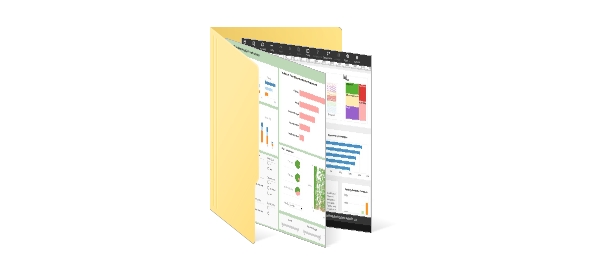InetSoft Product How-To: Create and Embed Dynamic Charts
Embedding InetSoft into Asset Tracking Software for Dynamic Analytics and Real-Time Dashboards
When a mid-tier asset tracking software company sought to enhance its analytics and visualization layer, it turned to InetSoft to embed dynamic charts, real-time dashboards, and self-service analytics directly into its existing application. The decision transformed the user experience and development lifecycle simultaneously—improving data interactivity, performance, and scalability while preserving the company’s control over UI design and deployment.
This integration story highlights how developers approached embedding InetSoft, what architectural and design considerations mattered, and how the tool’s flexibility aligned with modern asset tracking use cases.
Why Asset Tracking Applications Need Embedded Analytics
Asset tracking systems generate enormous volumes of granular data—from IoT sensors streaming GPS coordinates, temperature readings, and movement logs, to transactional records documenting assignments, maintenance, and usage. The challenge for developers isn’t collecting this data but presenting it coherently and interactively to business users. Legacy reports and static exports are inadequate for dynamic environments where assets move hourly and conditions fluctuate by the minute. Customers increasingly expect visual, drillable dashboards that show utilization patterns, route efficiency, equipment health, and predictive maintenance insights—all without switching to a separate analytics tool.
Embedding a BI platform like InetSoft into the asset tracking environment allows developers to satisfy these expectations while focusing internal development on core domain logic—device management, geofencing, notifications, and asset registration—rather than reinventing complex visualization frameworks or query builders.
Evaluating Options: Build vs. Embed
The software company’s engineering leadership began by assessing whether to expand their internal analytics module or embed a third-party solution. The build option promised full control but came with significant cost: maintaining visualization libraries, query optimizers, and data caching layers for real-time sensor feeds required specialized skills. Open-source visualization frameworks could handle static charts but lacked dynamic mashup capabilities, role-based access control, and multi-tenant scalability. Embedding an analytics platform offered speed and breadth—especially if the platform could integrate seamlessly with the company’s data architecture and user interface.
InetSoft’s combination of a lightweight, embeddable architecture, RESTful API access, and fine-grained security controls aligned with the developers’ design goals. Its modular embedding options allowed the asset tracking software to retain a consistent UI theme while gaining access to a robust BI engine capable of handling live data streams.
Architecture Overview: Layering InetSoft into the Stack
The asset tracking platform followed a cloud-native microservices architecture built around REST APIs, a central message broker, and multi-tenant PostgreSQL databases. InetSoft was deployed as a dedicated analytics microservice within this ecosystem. It connected directly to operational databases and message streams while caching snapshots for performance-sensitive dashboards. Authentication was unified through single sign-on (SSO) using JSON Web Tokens, and authorization roles were mirrored between the host application and InetSoft to enforce consistent permissions.
The embedding process leveraged InetSoft’s JavaScript API to render dashboards within existing UI containers. Developers exposed specific datasets—such as asset movement logs, utilization histories, and maintenance schedules—through controlled mashups that limited the data scope per tenant. The configuration avoided duplicating data pipelines by letting InetSoft read directly from existing API endpoints, reducing latency and synchronization complexity.
Data Modeling and Mashup Strategy
Developers needed flexible data modeling to accommodate varied client schemas and IoT data streams. InetSoft’s data mashup designer provided a visual and programmatic interface to blend structured relational tables with semi-structured JSON streams. This proved critical for integrating telematics data with transactional metadata, such as driver assignments or maintenance events. Developers defined reusable mashup templates, parameterized by tenant and time window, that supported high-volume queries while preserving resource isolation.
These mashups enabled dashboards to show real-time operational metrics—such as active asset count, route adherence, and idle-time ratios—alongside historical summaries. Because InetSoft handles aggregation logic at the BI layer, developers avoided writing complex SQL or MapReduce jobs for each visualization, significantly reducing backend development time. In effect, the mashup designer became a visual ETL layer embedded in the application’s runtime context.
UI Integration and Customization
Embedding InetSoft was designed to be visually seamless. Developers used its SDK to load dashboards within modular UI components built in React. CSS customization and theme mapping ensured charts inherited the host application’s color palette, typography, and spacing. Dashboards loaded through lazy initialization to minimize initial bundle size, enhancing perceived performance for end users. For users unaware of the underlying integration, the experience appeared fully native: the chart panels responded to the same filters, dropdowns, and map interactions as other components in the interface.
Developers created dynamic dashboard templates for different personas. Operations managers viewed asset performance grids and route deviation charts. Maintenance teams accessed parts usage and downtime analytics. Executives saw fleet utilization summaries and heat maps of regional efficiency. Because InetSoft supports parameterized dashboards, a single template could adapt dynamically based on user roles or region without duplicating code. This design pattern aligned perfectly with the company’s multi-tenant SaaS model.
Security and Tenant Isolation
Maintaining strict tenant isolation was a core requirement. InetSoft’s fine-grained role-based access control allowed the developers to implement a “data fence” model where each tenant could query only its assigned dataset. Tenant IDs were injected into mashup queries at runtime through token-based authentication, preventing cross-tenant data visibility. The system supported both per-tenant schema segregation and logical partitioning within shared databases, giving deployment flexibility for different customer tiers.
For audit and compliance needs, InetSoft’s query logs and user activity tracking were integrated into the platform’s monitoring layer. Administrators could view which dashboards were accessed, which parameters were used, and how frequently reports were generated—useful both for compliance audits and product analytics.
Real-Time Dashboards and Streaming Data
A standout feature for developers was InetSoft’s ability to handle near-real-time updates. The asset tracking system consumed telemetry through MQTT brokers, translating location updates and sensor readings into structured events. InetSoft subscribed to an internal event stream that pushed incremental updates to dashboards. Developers implemented a publish-subscribe adapter that fed data into InetSoft’s in-memory layer, enabling dashboards to refresh automatically without full-page reloads. This made it possible to display moving asset locations, changing utilization metrics, and live alerts in operational command centers.
From a development standpoint, this event-driven architecture avoided complex custom websocket logic in the core application. InetSoft’s internal refresh mechanics and data caching handled load efficiently, scaling to thousands of concurrent updates without saturating network bandwidth. The system balanced freshness and performance through configurable refresh intervals, allowing developers to fine-tune update frequency per visualization.
Developer Workflow and Automation
Embedding InetSoft changed how developers approached analytics deployment. Instead of manually exporting dashboard definitions, the team adopted infrastructure-as-code principles. Dashboards and mashups were stored as version-controlled XML configurations within the repository, allowing automated testing, review, and continuous deployment. Integration with CI/CD pipelines ensured that updates to dashboards or new data connections deployed automatically with application releases. Developers could run local instances of InetSoft for testing new visualizations before pushing them to staging or production environments.
Because InetSoft’s configuration files are human-readable, developers could script dashboard modifications or parameter injection without relying solely on a GUI. This hybrid of visual design and code-level control suited the team’s engineering culture and promoted transparency between analytics and backend development.
Performance Optimization
Performance tuning became an iterative process. Developers profiled query times and optimized mashups by introducing calculated fields and pre-aggregated tables. InetSoft’s caching layer was configured to store frequently accessed aggregates—like daily utilization summaries or maintenance cost rollups—reducing database load. Developers also leveraged InetSoft’s incremental refresh capability to update only changed data rather than re-querying full datasets, a major benefit for tenants managing thousands of assets.
Frontend optimization included asynchronous loading and viewport-based rendering to ensure large dashboards remained responsive. Developers used browser performance metrics to benchmark render times and found that InetSoft’s WebGL-accelerated visualizations performed consistently even on mid-range hardware. Combined with CDN caching for static assets, the embedded analytics experience met the same responsiveness expectations as the rest of the application.
Developer and User Benefits
From a developer’s perspective, embedding InetSoft significantly reduced maintenance overhead. Instead of maintaining a fragmented analytics subsystem, the team leveraged a unified engine that handled data connectivity, visualization, and interactivity. New dashboards could be built visually, versioned, and deployed rapidly. Developers could focus on enhancing the asset tracking domain—sensor integration, geofencing logic, and predictive maintenance algorithms—while InetSoft handled visualization complexity.
For end users, the benefits were tangible. Dashboards were richer, faster, and more interactive. Users could drill into asset hierarchies, filter by route or driver, and visualize data across multiple time horizons without exporting spreadsheets. Embedded dashboards supported better decision-making: dispatchers could optimize route plans in real-time, maintenance planners identified failing assets before breakdowns, and finance teams correlated asset utilization with depreciation schedules—all from within the same application interface.
Extensibility and Future Roadmap
The company’s roadmap includes extending InetSoft’s analytics beyond dashboards into embedded predictive analytics. With StyleBI’s support for integration with machine learning outputs, developers plan to surface predictive maintenance scores, anomaly detection alerts, and utilization forecasts alongside historical data. Embedding AI-driven insights in familiar dashboards avoids user friction and enhances adoption.
Developers are also experimenting with embedding InetSoft dashboards inside customer-facing mobile apps using responsive layouts and adaptive refresh rates. Because InetSoft dashboards are fully HTML5-native, mobile deployment requires minimal code adjustment, enabling real-time tracking summaries and maintenance alerts on handheld devices used by field personnel.
Lessons Learned and Best Practices
For developers considering embedding InetSoft into complex applications, several lessons emerged:
- Design security integration early. Align authentication and authorization models before embedding to avoid inconsistencies between app roles and BI permissions.
- Use parameterized dashboards. They enable dynamic rendering without duplicating definitions across tenants or regions.
- Automate deployments. Treat dashboard definitions like source code—version, test, and deploy through CI/CD pipelines.
- Monitor performance continuously. Use InetSoft’s query logs and dashboard metrics to fine-tune refresh intervals and caching strategies.
- Keep UX consistent. Align theme, typography, and interactivity with the host application to ensure the embedded analytics feel native.



